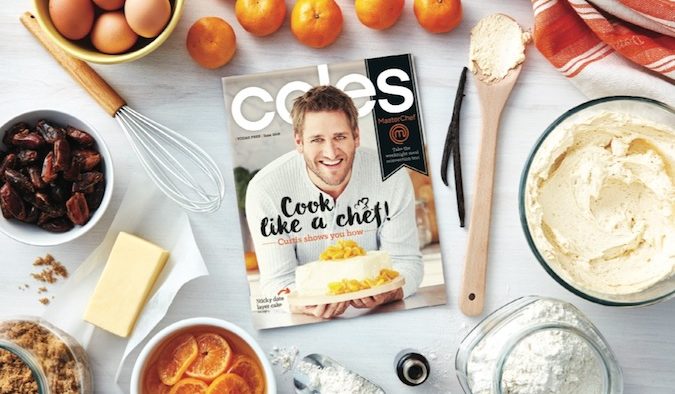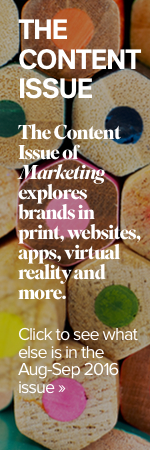Customer-driven content at Coles
Share

What goes on behind the scenes of the biggest content play in Australia? We chat with two of the brains at Coles about the importance of measurement and insight in planning and defining successful campaigns.
 With its Coles magazine, online and social media platforms, ‘At Home with Coles’ YouTube channels and partnership with online food giant Taste.com.au, Coles’ content marketing strategy stretches far and wide.
With its Coles magazine, online and social media platforms, ‘At Home with Coles’ YouTube channels and partnership with online food giant Taste.com.au, Coles’ content marketing strategy stretches far and wide.
Marketing speaks with Alex McDonald, Coles senior content manager, and Michelle Webb, head of digital marketing, about the sheer scale of creating content on various platforms for products and customers nationwide, and the importance of measurement and insight in planning and defining successful campaigns.
The story of Coles’ content marketing can be traced out from Coles magazine which, at 3.5 million, is the most read magazine in Australia. With its enormous reach and high engagement levels (readers purchase the featured products), Coles magazine solves the ‘what’s for dinner?’ dilemma of customers, promotes in-season produce, and hopefully, sees more people shop at Coles.
The decision to move the content program beyond print into online and social platforms was an obvious one, made in response to the ways in which consumers now engage with content, brands and one another.
McDonald recalls thinking: “We’ve got really valuable assets here that customers are loving; we need to get them into more channels, into the channels that are appropriate for that type of content.”
Developing a cohesive strategy across various online and social platforms was a beast of an undertaking, says McDonald. “With our content partner, Medium Rare, we identified customer needs, instigated content pillars, created content based on analytics and, importantly, developed tagging protocols for Medium Rare’s cloud- based DAM to store and share content,” she says.
It also meant working more closely with internal stakeholders to maximise the benefits across the business.
Teams were used to more conventional ways of communicating with customers. It was about saying, ‘Well, if you include this content and link it to the messages you’ve already got within your EDMs, you’re going to get better click-through and engagement rates’.
“It’s also about being cost-effective. By planning multi-platform content, we can create a single recipe that can reach over six million Australians.”
Support and involvement from all involved is key to the success of the content strategy, says McDonald. “It’s vital that the different stakeholders across the business are aligned, because they’re the ones who are going to bring the content plan to life. Agreeing on content pillars, goals and KPIs upfront makes the implementation easier.
Constant testing, analysis and planning are paramount to the ongoing success of the initiative, says McDonald. “We’ve done a lot of tests and learned what kind of content works best on different channels.
“On a quarterly basis, from a planning perspective, we talk the teams through the insights behind what content we’ve created, whether it’s video for social, YouTube or EDMs, or whether it’s recipes for magazine, catalogues or online,” says McDonald.
Head of digital marketing, Michelle Webb works across Coles supermarkets’ digital advertising, social media, ecommerce, content and web assets – which includes the Coles app. Her role covers the entire customer path to purchase and all aspects of Coles Supermarkets’ business, to which the content program is now inextricably linked.
Webb gives an idea of just how deeply integrated content is in Coles’ business strategies. “The content program is now in everything we do,” she explains.
“It’s part of social media. It’s integrated into our websites. It’s integrated into above-the-line campaigns. It’s probably part of every program I touch in some shape or form.
”It doesn’t stop there. Once in the content program, material is spread throughout various platforms and media. Content that was previously just printed in the magazine is repurposed in many ways. “How could we shoot that? Do we make a video? Do we make a gif? Do we make it something we can use across all our channels?” asks Webb.
In terms of planning a content piece from the start, the worst thing you can do is create content for content’s sake, says McDonald. So what comes first? According to Webb, the content planning begins with product and season. “Fortunately, we have thousands of products to feature at any one time. We know what’s in season and we have the insights to know what customers are searching for.
“We’re not trying to create a new trend. We say, people at this time love banana bread, we have bananas. How do we present that differently and uniquely so that they engage the content, and ultimately see it as beneficial and want to shop at Coles?”
So really, product and customer come hand in hand when planning content.
Central to this is customer insight data and analysis. “It’s about finding out the real passion points of our customers, the things they talk about, that they want to share, that they get excited about,” says McDonald.
“Dig in to the insights behind what drive people’s behaviour, and what makes their day easier or better, or a little bit more exciting. It’s about building opportunities to share content that really resonates with them.”
For Webb, the reason this content works so well with customers, and has real value, is because it makes their lives easier. “You need to understand the customer needs, and make sure you can actually help the customer. With all digital, I really do believe our role is to make it easier to feed the family,” she says.
Coles’ wide customer base and product range offers rich data on what customers buy and when. Its partnership with Taste.com.au – which comes with its own set of user data – offers further insights.
This detailed knowledge of customers’ wants and needs is helpful not only in planning what content to produce, but also in choosing the platform for which it would be most effective.
In monthly planning sessions, the teams “look at those insights, growing food trends, what’s selling and key seasonal products to feature,” explains Webb.
”We plan around that, and make sure we’ve got food content customers want, based on season, that also links to purchase.”
A multi-channel approach allows Coles to apply different levels of segmentation – usually casting a wide net with print content and employing more detailed targeting across social platforms.
Measurement also proves vital when presenting results of content campaigns, proving the impact, success and return, “to justify the investment,” says Webb.
The explosion of creative cooking in the home kitchen seen over the past few years has no doubt created the perfect backdrop for content marketing centred on recipes and food tips.
Partially responsible for the trend are TV programs like MasterChef and My Kitchen Rules along with celebrity chefs such as Heston Blumenthal – all three providing Coles with valuable further branding and product placement opportunities.
Recipes across all of its channels point customers in the direction of products and specials. “People are always going to look for new ways and innovations to make the family happy, but also to do it on a budget,” Webb says.
Is the foodie trend one that, like others, we can expect to plateau and then taper off? Webb doesn’t think so. “I don’t expect that trend to drop off. We’re humans, we love food, we want taste,” she says.
‘What’s for dinner?’ weekly catalogue recipes are an example of a very targeted, structured content offering. “Catalogue readers are such planners, and they love to sit down and work through all the specials.
“When you give them a recipe that’s linked to a special, they find that really helpful, because it’s so tied into their mission,” says McDonald.
Social media posts, for Facebook or Instagram, provide broader channels for content, which can be all about inspiration, she says. “I tend to focus on the insights,” says Webb, “having connected information about the customers, making sure we measure everything we do.
“If I understand the customer and the insights, I can then later change the way I serve that content out.”
While food trends and the way people engage with content and material online are changing rapidly and impossible to predict, Webb and McDonald believe measurement is the key to remaining relevant, and driving successful content campaigns into the future.
“It’s something we grapple with,” says McDonald. “It’s about content being queen. What type of content works really well in what type of channel, for which type of customer?”
“We’re working really well with the content that we have, but for me it’s ‘how do we amplify that even further?’ I think that’s the future of where we’re going,” concludes Webb.
_
This article was originally published in The Content Issue and made possible thanks to Issue Partner Medium Rare Content Agency.















